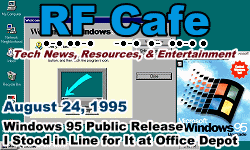|
 August 24 August 24
 1635: The first recorded hurricane
in America occurred at
Plymouth Colony. 1814: British forces captured Washington,
D.C., and
burned down
many landmarks including the Capitol and the White House. 1832:
Sadi Carnot,
who investigated the efficiencies of steam engines and for whom the Carnot Cycle is named,
died. 1888:
Rudolf Clausius,
who developed the 2nd law of thermodynamics, died. 1891:
Thomas Edison patented his
motion picture camera. 1909:
The first concrete was poured for the
Panama Canal. 1932: Amelia Earhart
became the first woman to fly non-stop across the United States. 1956: A U.S. Army
H-21 helicopter became the first rotary-winged aircraft to fly non-stop
across the United States. 1966: The USSR launched the
Luna 11, which orbited the
Moon while for the first time keeping in constant radio contact with earth. 1968: France
exploded a hydrogen bomb over a South Pacific testing ground and became the
world's 5th thermonuclear power. 1992: China and South Korea established
diplomatic ties. 1995:
Windows 95 debuted
- I remember standing outside Office Depot waiting for the doors to open. 1997:
Louis Essen, who invented the quartz crystal ring clock and the first
practical atomic clock, died. 1635: The first recorded hurricane
in America occurred at
Plymouth Colony. 1814: British forces captured Washington,
D.C., and
burned down
many landmarks including the Capitol and the White House. 1832:
Sadi Carnot,
who investigated the efficiencies of steam engines and for whom the Carnot Cycle is named,
died. 1888:
Rudolf Clausius,
who developed the 2nd law of thermodynamics, died. 1891:
Thomas Edison patented his
motion picture camera. 1909:
The first concrete was poured for the
Panama Canal. 1932: Amelia Earhart
became the first woman to fly non-stop across the United States. 1956: A U.S. Army
H-21 helicopter became the first rotary-winged aircraft to fly non-stop
across the United States. 1966: The USSR launched the
Luna 11, which orbited the
Moon while for the first time keeping in constant radio contact with earth. 1968: France
exploded a hydrogen bomb over a South Pacific testing ground and became the
world's 5th thermonuclear power. 1992: China and South Korea established
diplomatic ties. 1995:
Windows 95 debuted
- I remember standing outside Office Depot waiting for the doors to open. 1997:
Louis Essen, who invented the quartz crystal ring clock and the first
practical atomic clock, died.
| Jan
| Feb | Mar |
Apr | May |
Jun | Jul |
Aug | Sep |
Oct | Nov |
Dec |
Note: These
historical tidbits have been collected from various sources, mostly on the Internet.
As detailed in
this article, there
is a lot of wrong information that is repeated hundreds of times because most websites
do not validate with authoritative sources. On RF Cafe, events with
hyperlinks have been verified. Many years ago,
I began commemorating the birthdays of notable people and events with
special RF Cafe logos.
Where available, I like to use images from postage stamps from the country where
the person or event occurred. Images used in the logos are often from open source
websites like Wikipedia, and are specifically credited with a hyperlink back to
the source where possible.
Fair Use laws permit
small samples of copyrighted content.
|
 August 24
August 24